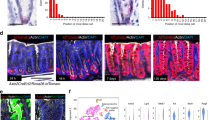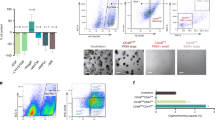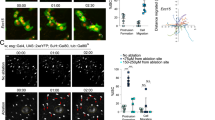Abstract
Epithelial integrity in metazoan organs is maintained through the regulated proliferation and differentiation of organ-specific stem and progenitor cells. Although the epithelia of organs such as the intestine regenerate constantly and thus remain continuously proliferative1, other organs, such as the mammalian urinary bladder, shift from near-quiescence to a highly proliferative state in response to epithelial injury2,3,4. The cellular and molecular mechanisms underlying this injury-induced mode of regenerative response are poorly defined. Here we show in mice that the proliferative response to bacterial infection or chemical injury within the bladder is regulated by signal feedback between basal cells of the urothelium and the stromal cells that underlie them. We demonstrate that these basal cells include stem cells capable of regenerating all cell types within the urothelium, and are marked by expression of the secreted protein signal Sonic hedgehog (Shh). On injury, Shh expression in these basal cells increases and elicits increased stromal expression of Wnt protein signals, which in turn stimulate the proliferation of both urothelial and stromal cells. The heightened activity of this signal feedback circuit and the associated increase in cell proliferation appear to be required for restoration of urothelial function and, in the case of bacterial injury, may help clear and prevent further spread of infection. Our findings provide a conceptual framework for injury-induced epithelial regeneration in endodermal organs, and may provide a basis for understanding the roles of signalling pathways in cancer growth and metastasis.
This is a preview of subscription content, access via your institution
Access options
Subscribe to this journal
Receive 51 print issues and online access
$199.00 per year
only $3.90 per issue
Buy this article
- Purchase on Springer Link
- Instant access to full article PDF
Prices may be subject to local taxes which are calculated during checkout




Similar content being viewed by others
References
van der Flier, L. G. & Clevers, H. Stem cells, self-renewal, and differentiation in the intestinal epithelium. Annu. Rev. Physiol. 71, 241–260 (2009)
Hung, C. S., Dodson, K. W. & Hultgren, S. J. A murine model of urinary tract infection. Nature Protocols 4, 1230–1243 (2009)
Mysorekar, I. U. & Hultgren, S. J. Mechanisms of uropathogenic Escherichia coli persistence and eradication from the urinary tract. Proc. Natl Acad. Sci. USA 103, 14170–14175 (2006)
Mysorekar, I. U., Isaacson-Schmid, M., Walker, J. N., Mills, J. C. & Hultgren, S. J. Bone morphogenetic protein 4 signaling regulates epithelial renewal in the urinary tract in response to uropathogenic infection. Cell Host Microbe 5, 463–475 (2009)
Hicks, R. M. The mammalian urinary bladder: an accommodating organ. Biol. Rev. Camb. Philos. Soc. 50, 215–246 (1975)
Kurzrock, E. A., Lieu, D. K., Degraffenried, L. A., Chan, C. W. & Isseroff, R. R. Label-retaining cells of the bladder: candidate urothelial stem cells. Am. J. Physiol. Renal Physiol. 294, F1415–F1421 (2008)
Hooton, T. M. & Stamm, W. E. Diagnosis and treatment of uncomplicated urinary tract infection. Infect. Dis. Clin. North Am. 11, 551–581 (1997)
Klumpp, D. J. et al. Uropathogenic Escherichia coli induces extrinsic and intrinsic cascades to initiate urothelial apoptosis. Infect. Immun. 74, 5106–5113 (2006)
Podlasek, C. A., Barnett, D. H., Clemens, J. Q., Bak, P. M. & Bushman, W. Prostate development requires Sonic hedgehog expressed by the urogenital sinus epithelium. Dev. Biol. 209, 28–39 (1999)
Haraguchi, R. et al. Molecular analysis of coordinated bladder and urogenital organ formation by Hedgehog signaling. Development 134, 525–533 (2007)
Karhadkar, S. S. et al. Hedgehog signalling in prostate regeneration, neoplasia and metastasis. Nature 431, 707–712 (2004)
Bai, C. B., Auerbach, W., Lee, J. S., Stephen, D. & Joyner, A. L. Gli2, but not Gli1, is required for initial Shh signaling and ectopic activation of the Shh pathway. Development 129, 4753–4761 (2002)
Lawson, D. A., Xin, L., Lukacs, R. U., Cheng, D. & Witte, O. N. Isolation and functional characterization of murine prostate stem cells. Proc. Natl Acad. Sci. USA 104, 181–186 (2007)
Harfe, B. D. et al. Evidence for an expansion-based temporal Shh gradient in specifying vertebrate digit identities. Cell 118, 517–528 (2004)
Muzumdar, M. D., Tasic, B., Miyamichi, K., Li, L. & Luo, L. A global double-fluorescent Cre reporter mouse. Genesis 45, 593–605 (2007)
Wu, X. R. & Sun, T. T. Molecular cloning of a 47 kDa tissue-specific and differentiation-dependent urothelial cell surface glycoprotein. J. Cell Sci. 106, 31–43 (1993)
Ahn, S. & Joyner, A. L. Dynamic changes in the response of cells to positive Hedgehog signaling during mouse limb patterning. Cell 118, 505–516 (2004)
Kimura, H., Stephen, D., Joyner, A. & Curran, T. Gli1 is important for medulloblastoma formation in Ptc1+/− mice. Oncogene 24, 4026–4036 (2005)
Hagberg, L. et al. Ascending, unobstructed urinary tract infection in mice caused by pyelonephritogenic Escherichia coli of human origin. Infect. Immun. 40, 273–283 (1983)
Goessling, W. et al. Genetic interaction of PGE2 and Wnt signaling regulates developmental specification of stem cells and regeneration. Cell 136, 1136–1147 (2009)
Lustig, B. et al. Negative feedback loop of Wnt signaling through upregulation of conductin/axin2 in colorectal and liver tumors. Mol. Cell. Biol. 22, 1184–1193 (2002)
Klein, P. S. & Melton, D. A. A molecular mechanism for the effect of lithium on development. Proc. Natl Acad. Sci. USA 93, 8455–8459 (1996)
Su, L. K. et al. Multiple intestinal neoplasia caused by a mutation in the murine homolog of the APC gene. Science 256, 668–670 (1992)
Fendrich, V. et al. Hedgehog signaling is required for effective regeneration of exocrine pancreas. Gastroenterology 135, 621–631 (2008)
Nicolle, L. E. Uncomplicated urinary tract infection in adults including uncomplicated pyelonephritis. Urol. Clin. North Am. 35, 1–12 (2008)
Foxman, B. Recurring urinary tract infection: incidence and risk factors. Am. J. Public Health 80, 331–333 (1990)
Yauch, R. L. et al. A paracrine requirement for hedgehog signalling in cancer. Nature 455, 406–410 (2008)
Tian, H. et al. Hedgehog signaling is restricted to the stromal compartment during pancreatic carcinogenesis. Proc. Natl Acad. Sci. USA 106, 4254–4259 (2009)
Bubendorf, L. et al. Metastatic patterns of prostate cancer: an autopsy study of 1,589 patients. Hum. Pathol. 31, 578–583 (2000)
Wallmeroth, A. et al. Patterns of metastasis in muscle-invasive bladder cancer (pT2–4): an autopsy study on 367 patients. Urol. Int. 62, 69–75 (1999)
Kurzrock, E. A., Lieu, D. K., deGraffenried, L. A. & Isseroff, R. R. Rat urothelium: improved techniques for serial cultivation, expansion, freezing and reconstitution onto acellular matrix. J. Urol. 173, 281–285 (2005)
Ibla, J. C. & Khoury, J. Methods to assess tissue permeability. Methods Mol. Biol. 341, 111–117 (2006)
Acknowledgements
We thank A. Oro and J. Brooks for their critical reading of the manuscript, and the Stanford Center for Digestive Diseases for help with laser capture microdissection. This research was supported in part by grants from the Department of Defense and from the National Institutes of Health (P.A.B.) and a Pathway to Independence Award (K99/R00) to I.U.M. P.A.B. is an investigator of the Howard Hughes Medical Institute.
Author information
Authors and Affiliations
Contributions
K.S. and P.A.B. conceived ideas and experimental design. K.S. performed the experiments. N.G. aided in immunohistochemical analysis, J.L. and J.K. helped with mouse strains, A.L. assisted with in vitro cell culture studies, L.Q. performed the genotyping of experimental mice, and I.U.M. helped analyse data. K.S. and P.A.B wrote the manuscript.
Corresponding authors
Ethics declarations
Competing interests
The authors declare no competing financial interests.
Supplementary information
Supplementary Information
The file contains Supplementary Figures 1-19 with legends and Supplementary Tables 1-6. (PDF 25818 kb)
Supplementary Movie 1
The movie shows an organoid grown by culturing FACS-isolated Shh-expressing cells for 7 weeks in Matrigel was imaged and a portion was reconstructed from approximately ••• of the series of confocal EGFP images (Supplementary Fig. 11g,i). This reconstruction was rotated to display the shape and lumen of the organoid. Bladder cells were isolated directly from TM-injected ShhCreER/WT; R26mTmG/WT mice (Imaris software, Bitplane Scientific Software). (MPG 3172 kb)
Supplementary Movie 2
The movie shows organoid grown from a single cell and imaged as in Supplementary Movie 1, except that cells derived from a previously grown organoid (P1 organoid; Supplementary Fig. 11h,j; Imaris software, Bitplane Scientific Software). (MPG 2850 kb)
Rights and permissions
About this article
Cite this article
Shin, K., Lee, J., Guo, N. et al. Hedgehog/Wnt feedback supports regenerative proliferation of epithelial stem cells in bladder. Nature 472, 110–114 (2011). https://doi.org/10.1038/nature09851
Received:
Accepted:
Published:
Issue Date:
DOI: https://doi.org/10.1038/nature09851
This article is cited by
-
The urothelial gene regulatory network: understanding biology to improve bladder cancer management
Oncogene (2024)
-
Implantation of adipose-derived mesenchymal stem cell sheets promotes axonal regeneration and restores bladder function after spinal cord injury
Stem Cell Research & Therapy (2022)
-
Urological cancer organoids, patients' avatars for precision medicine: past, present and future
Cell & Bioscience (2022)
-
Bladder cancer, inflammageing and microbiomes
Nature Reviews Urology (2022)
-
The dynamic roles of the bladder tumour microenvironment
Nature Reviews Urology (2022)
Comments
By submitting a comment you agree to abide by our Terms and Community Guidelines. If you find something abusive or that does not comply with our terms or guidelines please flag it as inappropriate.



